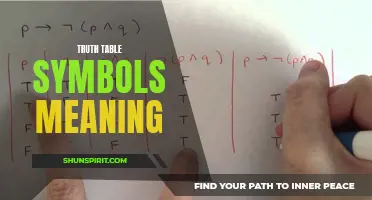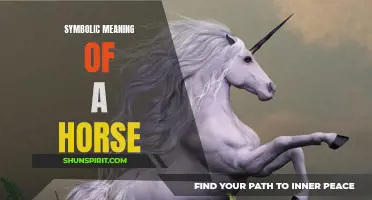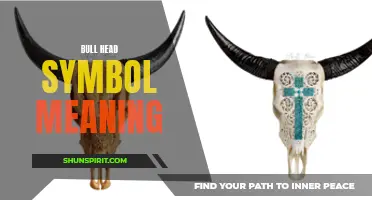
The Inca civilization is known for its rich symbolism and intricate iconography. Their symbols have deep meanings and were used to communicate messages and convey important concepts. From the powerful sun and moon symbols to the intricate geometric patterns, each symbol carries a unique significance in Inca culture. Today, we will explore the fascinating world of Inca symbol meanings and unravel the hidden messages behind these ancient glyphs. So let's dive in and discover the secrets of the Inca symbol world!
What You'll Learn
- What are some commonly recognized Inca symbols and their meanings?
- How did the Inca civilization use symbols in their everyday life?
- What is the significance of the Inca sun symbol and what does it represent?
- Are there any Inca symbols that are still used today in modern culture?
- How were Inca symbols used in their art and architecture?

What are some commonly recognized Inca symbols and their meanings?
The Inca civilization, which thrived in the Andes Mountains of South America from the 13th to the 16th centuries, left behind a rich legacy of art and symbolism. The Incas used symbols to convey important meanings and messages, whether through textiles, pottery, or architecture. Here are a few of their most commonly recognized symbols and their meanings:
- Inti: Inti was the Inca sun god, and his symbol was a radiant sun with a face. The sun was central to Inca religion and represented prosperity, fertility, and life itself. It was also associated with the emperor, who was believed to be a direct descendent of Inti.
- Chakana: The Chakana, also known as the Andean cross, is a square- or diamond-shaped symbol with stepped sides. It represents the Inca's cosmology and worldview, with each step symbolizing a different level of existence. The Chakana is often associated with balance, harmony, and the connection between the earthly and spiritual realms.
- Condor: The condor was a sacred bird in Inca culture and symbolized power, freedom, and the heavens. It was believed to be the messenger between the earthly and celestial worlds. The condor is often depicted with its wings outstretched and is a common motif in Inca art.
- Puma: The puma, or cougar, was another significant animal in Inca culture and was associated with strength, agility, and leadership. It represented the terrestrial realm and was often depicted alongside the condor to symbolize the connection between the earthly and celestial realms.
- Suyu: Suyu was the Inca term for the four geographic regions that made up their empire: Chinchaysuyu (north), Antisuyu (east), Kontisuyu (south), and Collasuyu (west). Each suyu had its own symbol, known as a topu, which represented the animal associated with that region. For example, Chinchaysuyu was represented by a jaguar, symbolizing strength and power.
- Inca Knots: Inca knots, also known as quipus, were a system of colored strings and knots used for record-keeping. While their exact meanings are still debated, they likely represented important data such as population censuses, tax records, and historical events.
These are just a few examples of the many symbols used by the Inca civilization. Each symbol carried its own significance and was used to communicate important messages about the Inca's spiritual beliefs, social structure, and relationship with the natural world. Today, these symbols continue to fascinate and inspire people around the world, offering a glimpse into the rich cultural heritage of the Inca civilization.
The Intriguing Meanings Behind Chinese Symbols
You may want to see also

How did the Inca civilization use symbols in their everyday life?
The Inca civilization, which thrived in ancient Peru from the 13th to the 16th century, used symbols extensively in their everyday life. These symbols held great significance and were an integral part of their culture and belief system. They were used in various aspects of their society, ranging from architecture to textiles.
One of the main ways the Incas used symbols was through their architecture. The most famous example of this is Machu Picchu, the iconic Inca city nestled in the Andes mountains. The city was built in the shape of a condor, which was a sacred animal in Inca mythology. The condor symbolized power and was associated with the sun god Inti. By constructing their city in the shape of a condor, the Incas were paying homage to their deities and symbolizing their connection with the divine.
Symbols were also commonly used in Inca textiles. The Incas were skilled weavers and created intricate textiles using natural materials such as cotton and alpaca wool. These textiles were not just for functional purposes but also served as a form of communication. Each pattern and color used in the textiles had a specific meaning. For example, the color red symbolized power and the color blue represented the sky and the divine. The Incas used these symbols to convey important messages and to express their social status and identity.
In addition to architecture and textiles, symbols were also important in Inca religious rituals. The Incas believed in a pantheon of gods and regularly held ceremonies to honor them. One of the most important symbols in their religious rituals was the chakana, also known as the Inca cross. This symbol represented the three realms of the Inca cosmology: the underworld, the earth, and the heavens. It was believed to connect these realms and provide a path for communication with the divine. The Incas would often wear or display the chakana during religious ceremonies and offerings.
Symbols were also used in the Inca system of record-keeping, known as the quipu. Quipus were intricate arrangements of colored strings that represented different quantities and meanings. Knots tied on the strings held numerical values, and the placement and arrangement of the knots represented different information such as census data, tax records, and historical events. The quipus served as a unique and efficient way for the Incas to keep records and convey information.
In conclusion, the Inca civilization heavily relied on symbols in their everyday life. These symbols were used in various aspects of their society, including architecture, textiles, religious rituals, and record-keeping. They held deep cultural and religious significance and played a crucial role in communicating important messages and expressing identity. The Inca civilization's use of symbols demonstrates their advanced understanding of visual communication and their rich belief system.
The Hidden Meanings of Chinese Symbol Tattoos Behind the Ear
You may want to see also

What is the significance of the Inca sun symbol and what does it represent?
The Inca sun symbol holds great significance in Inca culture and is revered as a representation of their powerful sun god, Inti. Known as the Inti Raymi or "Festival of the Sun," this symbol played a central role in Inca rituals and ceremonies. It symbolizes the divine connection between the sun god and the Inca civilization.
The Inca civilization considered the sun god, Inti, to be the most important deity. They believed that Inti controlled the cycles of nature and the fertility of the land. As agriculture was the backbone of the Inca society, the sun symbol became a crucial symbol of prosperity and abundance.
The Inca sun symbol features a face with a radiant expression and rays extending outwards from the center. The face is often depicted with a headdress or mask, symbolizing the power and divinity of the sun god. The rays represent the life-giving energy and warmth provided by the sun.
During the Inti Raymi festival, which took place at the time of the winter solstice, the Inca would gather to honor and pay tribute to Inti. The festival involved elaborate ceremonies, dances, and sacrifices, all aimed at ensuring the continued favor of the sun god.
The Inca believed that the sun symbolized the emperor's divine right to rule and his connection to Inti. The emperor was considered the son of Inti and was viewed as a representative of the sun god on Earth. The sun symbol was prominently displayed in the city of Cusco, the capital of the Inca Empire, as well as in other important Inca sites.
In addition to its religious significance, the Inca sun symbol also had practical uses. The Inca developed an intricate agricultural system known as terracing, where crops were grown on stepped platforms built into the mountainsides. The orientation of these terraces was carefully planned to maximize sun exposure and ensure optimal growing conditions. The sun symbol served as a reminder of the importance of the sun's energy in sustaining their agricultural practices.
Today, the Inca sun symbol continues to hold cultural and historical significance in Peru and is often used as a representation of Inca heritage. It is a powerful symbol that reminds us of the Inca civilization's deep reverence for the sun and the essential role it played in their lives. The sun symbol serves as a connection to our ancestors, symbolizing the bond between humanity and the natural forces that govern our world.
Decoding the Meaning Behind Mickey's Beer Cap Symbols
You may want to see also

Are there any Inca symbols that are still used today in modern culture?
The Inca civilization was known for its rich and complex symbolism, which heavily influenced Inca art, architecture, and religious beliefs. While the Inca Empire no longer exists, some of their symbols continue to be used in modern culture, reflecting the enduring legacy of this ancient civilization.
One of the most iconic symbols associated with the Inca is the Inti Raymi, or "Festival of the Sun." This annual celebration took place during the winter solstice and was dedicated to Inti, the Inca sun god. Today, the Inti Raymi is still celebrated in Cusco, Peru, attracting thousands of visitors who witness the procession and participate in traditional rituals. The festival serves as a reminder of the Inca's deep connection with the sun as a source of life and energy.
Another symbol that remains widely recognized in modern culture is the Chakana, also known as the Inca Cross. This symbol is composed of a square cross with stepped sides and a circle in the center. Each component of the Chakana holds special significance, representing elements of the Inca's cosmology and worldview. Today, the Chakana can be found in Peruvian art, jewelry, and even tattoo designs, serving as a symbol of pride and cultural identity.
The Inca also had a profound reverence for nature, and this is reflected in their use of animal symbolism. One such animal that continues to hold significance today is the condor. The condor was considered a sacred animal by the Inca and was often associated with the heavens and the spiritual realm. Today, the condor is still considered a national symbol of Peru and is featured prominently in the country's coat of arms.
Additionally, the Inca's respect for nature is also seen in their use of the puma as a symbol of strength, power, and leadership. The Incas believed that the puma represented the earth and was an important guardian of their empire. Today, the puma is still used as a symbol of strength and resilience in modern Peruvian culture.
Inca textiles also played a crucial role in their society and were often adorned with intricate patterns and designs. While many of these textiles have not survived, their motifs and symbolism continue to inspire contemporary Peruvian weavers. Today, these traditional weaving techniques are being revived, and Inca-inspired textiles can be seen in modern fashion, home decor, and art.
In conclusion, the Inca civilization left behind a rich legacy of symbolism, some of which still resonates in modern culture. The Inti Raymi, Chakana, condor, puma, and Inca textiles are just a few examples of the enduring symbols that continue to be used today. These symbols serve as a reminder of the Inca's profound spirituality, connection to nature, and artistic achievements, keeping their culture alive in the present day.
The Warrior Symbol: Unveiling the Meaning Behind this Ancient Emblem
You may want to see also

How were Inca symbols used in their art and architecture?
The Incas were an ancient civilization that thrived in the Andes Mountains of South America from the 13th to the 16th century. They are known for their remarkable art and architecture, which were heavily influenced by their rich culture and spirituality. Inca symbols played a crucial role in their artistic expression and architectural design, serving as a means of communication, representation, and religious significance.
One of the most prominent Inca symbols used in their art and architecture was the Inti, or the Sun symbol. The Incas worshiped the Sun as their primary deity, and this symbol represented their reverence for the Sun and its importance in their daily lives. The Inti symbol was often depicted as a golden disc with radiating rays and was prominently featured in Inca temples, palaces, and textiles. It symbolized life, light, and warmth, and its presence was believed to bring good fortune and protection.
Another important Inca symbol was the Chakana, or the Inca Cross. This symbol represented the three worlds of the Inca cosmology - the upper world of the gods, the middle world of humans, and the lower world of the dead. The Chakana symbol consisted of a cross with stepped levels and a square hole in the center. It was believed to connect the three worlds and served as a spiritual guide for the Inca people. The Chakana symbol was commonly incorporated into Inca textiles, pottery, and architectural structures, such as doorways and walls.
The Inca symbols were also used to depict the natural elements that were highly revered by the Incas. For example, the condor was considered a sacred bird by the Incas and symbolized power, freedom, and connection to the spiritual realm. Inca artists often depicted the condor in their artworks, showcasing its majestic wingspan and intimidating presence. Similarly, the puma symbolized strength, agility, and guardianship, and was commonly represented in Inca art and architecture.
In addition to these symbols, the Incas used a wide range of geometric shapes and patterns in their art and architecture. These shapes had symbolic meanings and represented various aspects of the Inca culture. For instance, the square symbolized the Earth and stability, while the circle represented eternity and the unity of all things. The Incas also incorporated intricate patterns of lines, curves, and angles into their artworks, often creating mesmerizing visual effects and optical illusions.
Inca symbols were not just decorative elements in their art and architecture, but were deeply intertwined with their religious and spiritual beliefs. They served as a visual language to convey important messages, tell stories, and express the Inca worldview. Every symbol had a specific meaning and significance, and their combination and arrangement added layers of symbolism and sacredness to the overall design.
To the Incas, art and architecture were much more than aesthetic expressions. They were a reflection of their culture, traditions, and beliefs. The use of symbols in their artistic creations and architectural designs was a way for the Incas to connect with the divine, honor their ancestors, and preserve their cultural heritage for future generations. The Inca symbols continue to inspire and fascinate people today, offering a glimpse into the rich and intricate world of the ancient Inca civilization.
The Ultimate Guide to Mitsubishi Shogun Dashboard Symbols and Meanings
You may want to see also
Frequently asked questions
The condor was a sacred bird in Inca culture and symbolized power, strength, and wisdom. It was believed to be a messenger between the heavens and the earth, and its presence was seen as a sign of good fortune. The Inca symbol of the condor also represented the Inca ruler, who was believed to have the spirit of the condor within them.
The sun was considered the most important deity in Inca religion, and its symbol represented the sun god Inti. The Inca believed that the sun was the source of all life and saw it as a powerful and benevolent force. The symbol of the sun also represented leadership, as the Inca rulers claimed to be direct descendants of the sun.
The serpent was a symbol of transformation and renewal in Inca culture. It was associated with the earth and the underworld, and represented the cyclic nature of life and death. The Inca believed that the serpent could bring about both destruction and rebirth, and its symbol was often used in rituals and ceremonies related to agriculture and fertility.
The chakana, also known as the Inca Cross, is a symmetrical three-stepped cross that represents the Inca worldview and cosmology. Each step of the cross is believed to represent a different realm - the lower world, the human world, and the upper world. The chakana symbolizes balance and harmony, and is often associated with concepts such as the interconnectedness of all things and the cyclical nature of life.
The llama was a sacred animal to the Inca and symbolized wealth, prosperity, and fertility. Llamas were valued for their wool, meat, and ability to carry heavy loads, and were often offered as sacrifices in religious ceremonies. The Inca symbol of the llama also represented the importance of agriculture and the domestication of animals in Inca society.



















